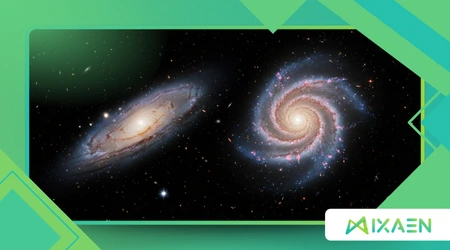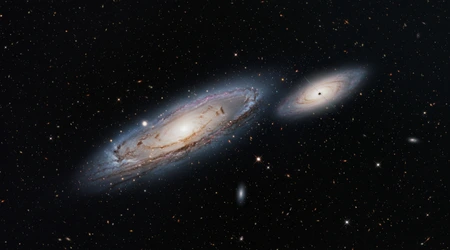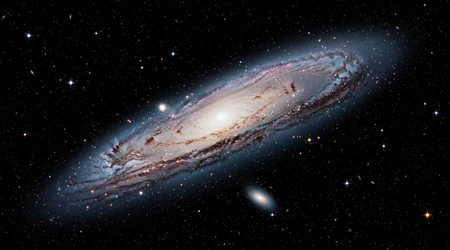Why Some Galaxies Don’t Seem to Have Dark Matter at All

Some galaxies don’t seem to have dark matter at all, a revelation that challenges the very foundations of modern cosmology.
Anúncios
Picture the universe as a grand tapestry, woven with galaxies, stars, and an invisible thread called dark matter, which scientists estimate makes up roughly 27% of the cosmos’ mass-energy.
Yet, certain galaxies, like NGC 1052-DF2, appear to defy this cosmic blueprint, showing little to no trace of this mysterious substance.
This anomaly sparks a question that keeps astronomers awake at night: how can galaxies form and function without the gravitational glue that dark matter provides?
This article dives into the enigma, exploring why some galaxies don’t seem to have dark matter at all, unraveling current research, and pondering what this means for our understanding of the universe.
From groundbreaking observations to theoretical debates, we’ll navigate this cosmic puzzle with fresh insights, avoiding recycled narratives, and grounding our exploration in verified science.
The discovery of these peculiar galaxies isn’t just a footnote in astronomy; it’s a loud knock on the door of established theories.
Since dark matter was first proposed to explain galaxy rotation curves, it’s been a cornerstone of cosmology, shaping how we understand galaxy formation.
But when some galaxies don’t seem to have dark matter at all, it’s like finding a house standing tall without a foundation.
This article will dissect the evidence, probe the implications, and spotlight ongoing research, including the pivotal work from the Hubble Space Telescope and the James Webb Space Telescope (JWST).
We’ll also weave in a touch of storytelling imagine a cosmic detective case where the usual suspect, dark matter, is missing from the scene. Ready to explore? Let’s venture into the void and uncover what these rebellious galaxies are telling us.
The Cosmic Outliers: What Are Dark Matter-Free Galaxies?
In 2018, astronomers using the Hubble Space Telescope stumbled upon NGC 1052-DF2, a galaxy with a shocking trait: some galaxies don’t seem to have dark matter at all.
This ultra-diffuse galaxy, located 65 million light-years away, showed stars moving far slower than expected, suggesting a lack of dark matter’s gravitational pull.
Unlike typical galaxies, where dark matter accounts for up to 90% of the mass, DF2’s mass came almost entirely from its visible stars and gas.
This finding sent ripples through the scientific community. Dark matter, invisible yet inferred through gravity, is thought to scaffold galaxy formation.
Without it, how does a galaxy hold together? The discovery of DF2, and later DF4, hinted at a new class of galaxies that challenge the standard model of cosmology.
To grasp this, consider a cosmic analogy: dark matter is like the unseen roots of a tree, anchoring it against cosmic winds. Yet, DF2 stands tall, defying this logic.
Astronomers hypothesize these galaxies might have formed in unique environments, perhaps stripped of dark matter by tidal interactions with larger galaxies.
++ Are There Stars Made Entirely of Dark Matter?
Current research, including 2025 JWST observations, continues to probe these outliers. Scientists are mapping their stellar populations to understand their formation.
The data suggests DF2’s stars are unusually uniform, hinting at a distinct evolutionary path that sidesteps dark matter’s influence.
But could these galaxies be a mirage? Some argue measurement errors or misinterpretations of velocity data might exaggerate the absence of dark matter.
Ongoing studies aim to refine these observations, ensuring the anomaly isn’t a cosmic sleight of hand.

The Science Behind the Anomaly: How Do We Know?
Detecting the absence of dark matter hinges on galaxy dynamics. Astronomers measure star velocities to infer mass.
In DF2, stars move sluggishly, implying minimal unseen mass thus, some galaxies don’t seem to have dark matter at all. A 2024 study in Nature confirmed DF2’s mass is nearly all baryonic, with dark matter contributing less than 1%.
Gravitational lensing, where light bends around massive objects, also tells the tale. In typical galaxies, lensing reveals dense dark matter halos.
Also read: The Great Silence: Why the Universe Isn’t Responding to Us
DF2 shows weak lensing, supporting the claim of minimal dark matter. The Subaru Telescope’s 2024 observations of the Coma Cluster further validated this.
Consider an example: imagine baking a cake without flour impossible, right? Dark matter is cosmology’s flour, yet DF2 is a perfectly baked galaxy without it. This paradox drives researchers to question whether dark matter is always essential.
Another clue lies in galaxy clusters. DF2 resides near NGC 1052, a massive elliptical galaxy. Tidal stripping, where a larger galaxy’s gravity strips material from a smaller one, might explain the dark matter deficit.
Simulations in 2025 suggest such interactions could eject dark matter, leaving only stars behind.
Yet, skepticism persists. Could low star velocities result from observational biases? New instruments, like the Dark Energy Spectroscopic Instrument (DESI), are mapping galaxy motions to confirm these findings, ensuring precision in this cosmic detective work.
| Galaxy | Estimated Dark Matter Fraction | Key Observation Method | Year Discovered |
|---|---|---|---|
| NGC 1052-DF2 | <1% | Stellar Velocity | 2018 |
| NGC 1052-DF4 | ~2% | Gravitational Lensing | 2019 |
| Typical Spiral | ~90% | Rotation Curves | – |
Theories Explaining the Dark Matter Deficit
So, why do some galaxies don’t seem to have dark matter at all? One theory suggests tidal stripping.
When a smaller galaxy passes near a massive one, gravitational forces can strip away dark matter, leaving a baryon-dominated remnant. Simulations from 2025 support this for DF2, located near NGC 1052.
Another idea points to formation quirks. Ultra-diffuse galaxies might form in high-velocity gas clouds, where dark matter never clumps significantly.
This could explain their sparse halos. Recent JWST data hints at such conditions in early universe environments.
Read more: Why the Cosmic Microwave Background Still Confuses Physicists
Alternatively, Modified Newtonian Dynamics (MOND) proposes gravity behaves differently at low accelerations, potentially negating the need for dark matter. However, MOND struggles to explain cluster-scale observations, making it less favored.
Picture a cosmic heist: a thief (a massive galaxy) steals dark matter from a smaller one. This scenario fits DF2’s context, but not all cases. Some galaxies might simply form without dark matter, a radical idea gaining traction.
Ongoing experiments, like those at the Large Hadron Collider, seek dark matter particles to test these theories. If none are found, the case for alternative gravity models strengthens, reshaping our cosmic understanding.
Implications for Cosmology: A Paradigm Shift?
The discovery that some galaxies don’t seem to have dark matter at all shakes cosmology’s foundations. If dark matter isn’t universal, our models of galaxy formation need retooling.
The standard Lambda-CDM model assumes dark matter’s ubiquity, yet DF2 suggests exceptions exist.
This anomaly could refine our understanding of dark matter’s role. If galaxies can form without it, perhaps baryonic processes are more versatile than thought.
A 2025 ScienceDaily report notes 100 potential dark matter-free galaxies around the Milky Way, urging further study.
What if dark matter isn’t the cosmic glue we thought? This question pushes researchers to explore alternative models, like warm dark matter or fuzzy dark matter, which predict fewer small galaxies, aligning with DF2-like cases.
These galaxies also challenge simulations. Current models predict many dwarf galaxies with dark matter halos. Finding ones without suggests our simulations miss key physics, prompting updates to supercomputer models.
The stakes are high. If some galaxies don’t seem to have dark matter at all, it could hint at new physics. Future observatories, like the Vera Rubin Observatory, will hunt for more such galaxies, potentially rewriting cosmology’s rulebook.
Consider another example: a chef crafting a dish without a key ingredient, yet it tastes divine. These galaxies force us to rethink the recipe of the universe, sparking innovation in theory and observation.
The Cosmic Web Connection: A Broader Context
Dark matter is thought to form the cosmic web, a network of filaments connecting galaxies. Yet, if some galaxies don’t seem to have dark matter at all, how do they fit into this structure?
Research from 2024 using the Subaru Telescope detected dark matter in the Coma Cluster’s filaments, but DF2-like galaxies appear detached.
These galaxies might form in voids, regions with sparse dark matter. This isolation could explain their unique makeup, as they avoid the web’s dense scaffolding. JWST’s 2025 observations of distant voids support this idea.
Alternatively, they could be remnants of violent cosmic events. Galaxy collisions might scatter dark matter, leaving behind baryon-rich relics. Simulations suggest such events were common in the early universe.
This raises a broader question: are these galaxies exceptions or a new norm? If common, they could reveal gaps in our understanding of the cosmic web’s evolution, pushing for more detailed surveys.
Future missions, like the Arrakhis project, aim to map diffuse structures, potentially uncovering more dark matter-free galaxies. These efforts will clarify whether the cosmic web is less uniform than we thought.
The Future of the Mystery: Where Do We Go From Here?

The puzzle of galaxies lacking dark matter demands new tools and ideas. Next-generation telescopes, like the Giant Magellan Telescope, will probe these galaxies’ structures with unprecedented detail, seeking clues to their origins.
Particle physics offers another path. If dark matter particles are found, their properties might explain why some galaxies lack them. Experiments at CERN are intensifying this search, with results expected by 2027.
Meanwhile, theorists are busy. New models propose dark matter varies in density across cosmic regions, explaining outliers like DF2. These ideas will be tested against upcoming DESI data.
Imagine a cosmic jigsaw puzzle with missing pieces. Each new observation of these galaxies adds a piece, slowly revealing the full picture. The journey is just beginning.
Ultimately, the question remains: why do some galaxies don’t seem to have dark matter at all? Solving this could unlock secrets of the universe’s birth, evolution, and fate, making it a thrilling time for cosmology.
Conclusion: Embracing the Cosmic Unknown
The discovery that some galaxies don’t seem to have dark matter at all is more than a scientific curiosity it’s a call to rethink the universe.
These cosmic rebels challenge our assumptions, pushing astronomers to refine theories and tools. From tidal stripping to alternative gravity models, the explanations are as diverse as the galaxies themselves.
As we peer deeper with JWST and DESI, each observation brings us closer to unraveling this mystery. The universe is a vast, untamed frontier, and these galaxies remind us that even our best maps are incomplete.
What other secrets lie hidden in the cosmos, waiting to upend our understanding? Let’s keep exploring, questioning, and marveling at the universe’s surprises.
Frequently Asked Questions
1. What are dark matter-free galaxies?
They’re galaxies, like NGC 1052-DF2, with little to no dark matter, detected via slow star velocities and weak gravitational lensing, challenging standard cosmology.
2. How do scientists know these galaxies lack dark matter?
By measuring star movements and gravitational lensing. For example, DF2’s stars move slower than expected, indicating minimal unseen mass.
3. Could this discovery change our understanding of the universe?
Yes, it suggests dark matter isn’t always essential for galaxy formation, potentially leading to new models of cosmic evolution or gravity.
4. Are there many dark matter-free galaxies?
Possibly up to 100 around the Milky Way, based on 2025 simulations, but more observations are needed to confirm their prevalence.
5. What’s next for studying these galaxies?
Future telescopes, like the Vera Rubin Observatory, and particle experiments at CERN will probe their origins, aiming to redefine cosmology’s foundations.
